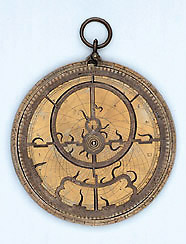
 |
| Catalogue |
 |
 Astrolabe The rete has pointers for 23 named stars. The east-west band is counterchanged 10 times. The ecliptic band has the named of the signs, each with a 30-degree scale divided to 10, subdivided to 2, not numbered. The outer band, for the tropic of Capricorn, is cut with 120 teeth, each marked with a dot, and there is an incomplete or worn scale marked with the months of the year. There are two plates for latitudes 42, 45 and 48, 51 degrees. On each there is an outer degree scale 0 to 360, divided to 5, subdivided to 1, numbered by 10. There are unnumbered almucantars and azimuths, circles for the equator and tropics, a crepuscular line, and east-west and meridian lines. There are divisions for unequal hours, numbered 1 to 12. The back has an outer degree scale 90 to 0 to 90 to 0 to 90, divided to 5, subdivided to 1, numbered by 5, and a zodiacal scale that shares the degree divisions in sections for each names zodiacal sign, 0 to 30, numbered by 5. Inside is an eccentric calendar scale with the months named in Latin. each with a scale of days divided to 5, subdivided to 1, numbered as appropriate by 5. The first point of Aries is at 111/4 March. The central space has a double shadow square and unequal hour diagram. Jim Bennett |



